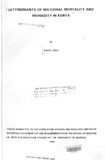| dc.description.abstract | The study attempts to examine the demographic, socio-economic and social determinants of maternal mortality and morbidity in Kenya using hospital based information of the Kenya Maternal Mortality Survey of 1994. In an attempt to determine the crucial factors that influence maternal mortality and morbidity in Kenya, the study analyzed 66,080 cases drawn from 19 district and provincial hospitals covered by the survey. The hospital information was collected using pre designed forms of three types. The first form was used to extract information from files of each woman admitted to the pregnancy ward. The basic information included age, parity, marital status, educational level attained, ante-natal and postnatal clinic attendance, medical history on the survival status of the patient at the time of discharge, and the cause of death if applicable. The second form was used to collect a summary information from the maternity and gynecology wards on the number of admissions, the number of deliveries by method and the number of maternal deaths. Lastly, the third form was a designed questionnaire administered to hospital personnel pertaining to major maternal mortality causes, ante-natal and postnatal services as well as referrals from traditional birth attendants admitted to the hospitals. The hospital-based maternal mortality statistics suffered selectivity bias in reflecting national level of maternal mortality, particularly in areas where women did not routinely give birth in the hospitals.
The data obtained was analyzed by the use of descriptive statistical methods involving the performance of percentages, frequencies, cross tabulation and logistic
regression through SPSS / PC+ computer program.
The primary finding of the study indicated that mothers age, parity, educational level attained, ante-natal and postnatal clinic attendance and province of residence were significant determinants of maternal mortality and morbidity in Kenya. The results further revealed that maternal deaths was highest among women of older reproductive ages (40 + years) and those of parity 7 +. With regard to maternal level of education on maternal mortality, there was a noted decreasing maternal deaths with an increase in level of education attained with a secondary+ level of education exhibiting the lowest maternal mortality incidence. Lastly the wide disparities in maternal mortality across the provinces with Nyanza and Coast Provinces experiencing higher maternal mortality incidence Eastern, Rift Valley and Central Provinces.
Based on these findings, a number of relevant recommendations to policy makers and areas of further research are suggested. In order to reduce maternal mortality, an intensive campaign has to be carried out by the government through the Ministry of Education to promote women education especially to higher levels (secondary+ ), expand provision of primary health care particularly the coverage of ante-nataland postnatal services to women equitably across all provinces. Further studies should be done to find out why some provinces exhibit higher maternal mortality than others and to establish whether the regional disparities across the provinces noted by hospital data also exist in the household / community based survey. Lastly, research should be done to- assess the impact of HIV/AIDS
prevalence on maternal mortality and morbidity given the close association
betweenthe AIDS pandemic and reproductive health. | en |

